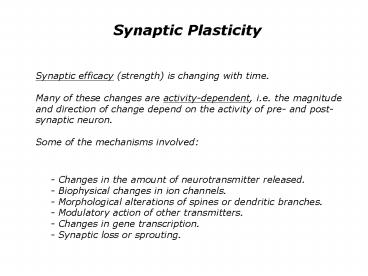Synaptic Plasticity - PowerPoint PPT Presentation
1 / 19
Title:
Synaptic Plasticity
Description:
Synaptic Plasticity. Synaptic efficacy (strength) is changing with time. ... a cell B and repeatedly and persistently takes part in firing it, some growth ... – PowerPoint PPT presentation
Number of Views:504
Avg rating:3.0/5.0
Title: Synaptic Plasticity
1
Synaptic Plasticity
Synaptic efficacy (strength) is changing with
time. Many of these changes are
activity-dependent, i.e. the magnitude and
direction of change depend on the activity of
pre- and post-synaptic neuron. Some of the
mechanisms involved
- Changes in the amount of neurotransmitter
released. - Biophysical changes in ion
channels. - Morphological alterations of spines
or dendritic branches. - Modulatory action of
other transmitters. - Changes in gene
transcription. - Synaptic loss or sprouting.
2
Hebbs Postulate
When an axon of cell A is near enough to excite
a cell B and repeatedly and persistently takes
part in firing it, some growth process or
metabolic change takes place in one or both cells
such that As efficiency, as one of the cells
firing B, is increased.
Donald Hebb, Organization of Behavior, 1949
3
Animal Models of Plasticity
Long-Term Potentiation (LTP)
Cross-section of the hippocampus
Cajals drawing
4
Animal Models of Plasticity
Brain slice preparation of the hippocampus
5
LTP
Typical LTP experiment record from cell in
hippocampus area CA1 (receives Schaffer
collaterals from area CA3). In addition,
stimulate two sets of input fibers.
6
LTP
Typical LTP experiment record EPSPs in CA1
cells (magnitude) Step 1 weakly stimulate input
1 to establish baseline Step 2 give strong
stimulus (tetanus) in same fibers (arrow) Step 3
continue weak stimulation to record increased
responses Step 4 throughout, check for responses
in control fibers (input 2)
7
LTP
LTP is input specific. LTP is long-lasting
(hours, days, weeks). LTP results when synaptic
stimulation coincides with postsynaptic
depolarization (achieved by cooperativity of many
coactive synapses during tetanus). The timing of
the postsynaptic response relative to the
synaptic inputs is critical. LTP has Hebbian
characteristics (what fires together wires
together, or, in this case, connects together
more strongly). LTP may produce synaptic
sprouting.
8
The NMDA Receptor
- At the resting potential (postsynaptic neuron),
glutamate binds to the NMDA channel, the channel
opens, but is plugged by a magnesium ion
(Mg2). - Depolarization of the postsynaptic membrane
relieves the magnesium block and the channel open
to allow passage of sodium, potassium and calcium.
9
The Associative Nature of LTP
Old(er) view Associative requirement is
mediated by the voltage-dependent characteristics
of the NMDA receptor. New discovery (1994)
Active conductances in dendrites mediate
back-propagation of APs into the dendritic tree.
10
Spike-Timing Dependent Plasticity
Basic Idea Change in synaptic strength depends
on the precise temporal difference between pre-
and post-synaptic neuronal firing (causality!).
11
The Neuron Integrator or Coincidence Detector?
Synchronous inputs really matter!
12
Data Analysis in Neurophysiology
Spike train data sets
Neuron in MT
Colby and Duhamel, 1991
13
Data Analysis in Neurophysiology
Neuron in IT (object selective)
Desimone et al., 1984
14
Data Analysis in Neurophysiology
Neurons in V1 (orientation selective)
PSTH (firing rate)
Auto-Correlation
Shift Predictor
Cross-Correlation
Engel et al., 1991
15
Neural Coding
Rate coding versus temporal coding
One major mechanism of how neurons encode
information is through their firing rate (number
of APs per second). Example orientation
selectivity. Another major mechanism is
synchronization (APs occurring together in
time). Example perceptual grouping. Synchrony
could affect other neurons (e.g. through spatial
summation see unit 1).
16
Computational Neuroscience
Components of (most) neural models
- Units and connections - Inputs and outputs -
Activation function - Learning rule
17
The McCullogh-Pitts Neuron
18
The McCullogh-Pitts Neuron
19
Why the Mind is in the Head
Why is the mind in the head? Because there,
and only there, are hosts of possible
connections to be formed as time and
circumstance demand. Each new connection,
serves to set the stage for others yet to come
and better fitted to adapt us to the world, for
through the cortex pass the greatest inverse
feedbacks whose function is the purposive life of
the human intellect. Warren S. McCullogh,
Hixon Symposium 1951.































